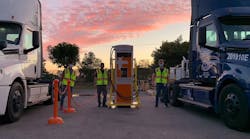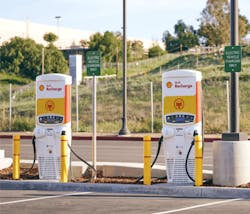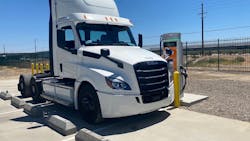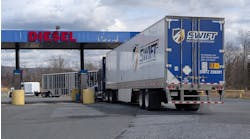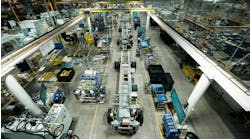With stricter state and federal emission regulations on the horizon, now is the time for fleets and original equipment manufacturers to plan their electrification strategies — and considering the complexities surrounding the paradigm shift to battery-electric vehicles, specifically surrounding charging, they will need all the time they can get.
California and New Jersey both have stated goals of eliminating sales of gas-and diesel-powered vehicles by 2035, part of a broader goal to cut all greenhouse gas emissions by 2050. The California Air Resources Board (CARB) plans to mandate that all medium- and heavy-duty vehicles are 100% zero-emission by 2045 “where feasible,” with 2035 the target set for drayage trucks. Along with thirteen other states and Washington D.C., California and New Jersey also signed a non-binding agreement to increase sales of zero-emission commercial vehicles to 30% of total CV sales in those areas by 2030.
The EV advantage
Along with meeting regulatory mandates, EVs also are expected to decrease maintenance costs and cost per mile to improve total cost of ownership (TCO). According to Dana Corp.’s TCO calculator, an electric regional haul truck costs 13 cents less per mile than that of a diesel.
Greenlots, a subsidiary of Shell that installs charging infrastructure, found that one customer, Yellow Cab of Columbus, recouped 50% of TCO by electrifying its fleet and using a DC Fast Charging solution.
“As more and more EV industry players emerge and navigate the landscape, finding the best fit charging solution to meet business objectives can be challenging,” said Greenlots COO Henrik Holland.
Greenlots, which helps fleet install and manage their chargers with software to optimize routes and energy pricing, has worked with the state of California and Volvo Group to vet the stability and reliability of an electric fleet through the Volvo Trucks North America (VTNA) LIGHTS (Low Impact Green Heavy Transport Solutions) project.
“We now know that heavy-duty EVs can now reliably charge at times when electricity rates are lower, safely integrating heavy-duty trucks into the grid,” Holland said. “Energy costs are more stable and lower than fueling costs, and maintenance costs are lower. With projects like Volvo LIGHTS coming online now, we’re able to examine what these savings really look like.”
That’s the endzone, but without the proper planning, overcoming the intricacies of installing the charging stations sometimes can be as formidable as the 1985 Chicago Bears defense.
“It’s been many months of going back and forth between the partners on the project to make sure that everything’s organized,” said Troy Musgrave, director of process improvement at Dependable Highway Express (Dependable), which took part in the Volvo LIGHTS project. “It’s very complicated to meet all the regulatory requirements and guidelines, too, because you have so many different partners involved, and everybody needs their criteria met.”
This includes what to do during rolling brownouts where electricity isn’t readily available. Dependable has a backup diesel generator as well as solar fields and battery storage.
Time is of the essence
During the ACT Virtual panel called “Foundation for Fleet Expansion – The Vision for the Electric Fleet Future,” industry leaders who represented charging infrastructure, truck manufacturing, and clean fleets all laid out the opportunities and obstacles related to this electrification push. This included Pasquale Romano, president and CEO of ChargePoint; Michael Scheib, eMobility Platform director at Daimler Trucks North America (DTNA); and Stephen Moelk, IKEA’s fulfillment project implementation manager.
Daimler Trucks and Buses, which through U.S. market leader DTNA produces Freightliner and Western Star trucks, has prepared for this electric eventuality by setting a company goal to only offer carbon-neutral commercial vehicles by 2039.
IKEA, which relies on third-party fleets and independent contractors to fulfill furniture deliveries, has an aggressive aim to utilize only zero-emissions delivery vehicles by 2025.
And full-scale electrification will be here in a relatively short timeframe, Romano said.
“It's only 15 years away — we're not looking at that many product cycles for a company like Daimler or that many life cycles for delivery logistics vehicles at IKEA,” Romano said. “It's a slow-moving flywheel, but it has a lot of energy.”
ChargePoint and other charging solution providers’ role is to ensure all that energy is channeled appropriately from the grid to the truck. This in the literal sense as well as the overarching electric ecosystem.
“[Electric vehicles have] to be available in volume, the service infrastructure for the vehicles has to be there and the charging infrastructure has to be there,” Romano said.
The OEM side
The service side is best examined in its own article, while the volume of electric trucks appears to be the least problematic component, as every OEM is exploring electric powertrains, with some, such as Xos Trucks, exclusively so. DTNA is currently testing Freightliner eCascadia (Class 8) and medium-duty eM2 106 battery-electric trucks with select customers, accruing more than 300,000 cumulative miles through its Freightliner Innovation Fleet. To help more fleets acquire these electric trucks, Scheib said DTNA’s telematics-based, pay-as-you-drive leasing program may also be available at some point.
Pilots are also being run through the Freightliner Customer Experience Fleet. Both the eCascadia and eM2 should enter production in 2021, with a range of 250 and 230 miles, respectively. These trucks are poised to excel in the regional haul and local delivery segments, as even fast-charging will take up to 90 minutes.
For the long haul segment, Daimler Truck and Volvo Group have also entered a partnership to explore hydrogen-powered fuel cell electric trucks that feature ranges in excess of 500 miles and fueling times comparable to that of diesel.
To highlight the difficulty in charging a truck on long trips, Scheib recalled the difficulty in moving its electric fleet from its headquarters in Portland, Ore. down the coast to California customers. “There is not a real network for charging in route for heavy-duty trucks,” he said. And when the tractors would stop at an available charging station, “you take up the whole real estate,” he said.
So for now, fleets must settle on installing their own infrastructure.
“We believe that depot charging, as we get started, is going to be the way we need to find energy for our vehicles,” explained DTNA President and CEO Roger Nielsen in August.
Scheib said DTNA has deployed 18 of ChargePoint’s CPF50 Level 2 charging stations at depot and customer locations.
Another consideration is that the electric rates may vary widely based on overall demand, with peak prices offsetting the TCO value proposition of electric vehicles.
“It's unpredictable if you charge once at 10 cents per kilowatt-hour and the next time that’s 40 cents per kilowatt-hour,” Scheib said. “We have figure out how to put forth stable cents-per-kilowatt prices out there if you want to move into more public charging on the truck side of things.”
ChargePoint noted on its website that customers can work with utilities to set up flat rates, time-of-use rates, and tiered rates. If a fleet can afford to charge at night, time-of-use would likely be the best option to take advantage of off-peak prices.
Scheib said off-peak charging presents “a lot of potential.”
“It’s not even a question; it’s an absolute given that you have to do that to make the TCO work,” he said. “You learn it the hard way when you charge at 45 cents per kilowatt-hour.”
Fleet side
“A lot of the conversation around electrifying fleets has been the ownership model, that TCO calculation,” IKEA’s Scheib said. “The bigger nut to crack are these independent contractors and getting those guys involved in the change. That's the tough part.”
He estimated that even more than two-thirds of commercial trucks are driven by independent contractors.
IKEA’s contractors use Classes 4 and 5 trucks for routes ranging from 80 to 140 miles per day, and deliveries must take place between 9 a.m. and 9 p.m. That makes overnight depot charging relatively easy.
Procuring electric trucks for its drivers is less so, though Moelk said in California and New York they are examining a rental model. “That way we de-risk the driver and the driver is able to get access to the electric vehicle without buying it,” he said.
In this model, the rental lots would have charging stations. He said while charging stations at restaurants and other retail stores are important, the logistic companies and industrial landlords who need to install charging.
IKEA also plans on owning some chargers, with help from the Low Carbon Fuel Standard credit in California. Moelke said IKEA would also use charging as a service (CHaaS) if a third-party carrier offered it.
“Our preference is not to have a gazillion chargers out there and own and operate these things,” Moelk said. “We are a furniture store, and we would rather sell more furniture.”
Whatever the charging for the fleet ends up looking like, Moelk said that there are customers who are willing to pay a premium for products delivered by zero-emission vehicles. And fleets that “sprinkle in” electric trucks are not addressing that demand.
“If I want electric vehicle delivery, and I'm willing to pay $3 more delivery, can you give it to me?” Moelk asks. “And the answer is no. It cannot stay that way. They can’t just react to TCO. These transportation companies have to react to customer demand as well.”
